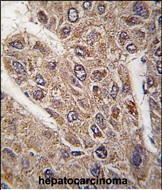

| WB | 咨询技术 | Human,Mouse,Rat |
| IF | 咨询技术 | Human,Mouse,Rat |
| IHC | 1/100-1/500 | Human,Mouse,Rat |
| ICC | 技术咨询 | Human,Mouse,Rat |
| FCM | 咨询技术 | Human,Mouse,Rat |
| Elisa | 咨询技术 | Human,Mouse,Rat |
| Aliases | Protein bicaudal D homolog 2, Bic-D 2, BICD2, KIAA0699 |
| Entrez GeneID | 23299 |
| WB Predicted band size | 93.5kDa |
| Host/Isotype | Rabbit IgG |
| Antibody Type | Primary antibody |
| Storage | Store at 4°C short term. Aliquot and store at -20°C long term. Avoid freeze/thaw cycles. |
| Species Reactivity | Human |
| Immunogen | This BICD2 antibody is generated from rabbits immunized with a KLH conjugated synthetic peptide between 787-818 amino acids from the C-terminal region of human BICD2. |
| Formulation | Purified antibody in PBS with 0.05% sodium azide,1%BSA and 50% glycerol.prepared by Saturated Ammonium Sulfate (SAS) . |
+ +
以下是3篇关于BICD2抗体的相关文献摘要概览:
1. **文献名称**: *BICD2 mutations in hereditary motor neuropathies*
**作者**: Neveling K et al.
**摘要**: 研究通过BICD2抗体检测发现BICD2基因突变导致神经元轴突运输缺陷,与遗传性脊髓性肌萎缩症(SMALED)相关,揭示了BICD2蛋白在动力蛋白-动力蛋白复合体中的关键作用。
2. **文献名称**: *Cryo-EM structure of the BICD2-CTD bound to dynein-dynactin complex*
**作者**: Chowdhury S et al.
**摘要**: 利用BICD2特异性抗体验证蛋白互作,解析了BICD2羧基端结构域与动力蛋白-动力蛋白复合体的冷冻电镜结构,阐明其在细胞内囊泡运输中的分子机制。
3. **文献名称**: *BICD2 mediates perinuclear anchoring of endosomes through dynein interaction*
**作者**: Hoogenraad CC et al.
**摘要**: 通过免疫荧光和BICD2抗体标记,证实BICD2通过连接动力蛋白与Rab6阳性内体,调控高尔基体周边内体的定位及神经细胞极性分化。
注:以上为简化示例,具体文献可通过PubMed/Google Scholar以“BICD2 antibody”、“BICD2 function”为关键词检索近年研究。实际应用中建议优先选择抗体验证实验(如Western blot/IP)明确的文献。
The BICD2 (Bicaudal D homolog 2) antibody is a crucial tool for studying the BICD2 protein, a key regulator of intracellular transport. BICD2 facilitates dynein-dynactin-mediated microtubule-based trafficking, essential for organelle positioning, mRNA localization, and neuronal development. It acts as an adaptor, linking cargoes like vesicles, organelles, and mRNA complexes to the dynein motor, enabling their retrograde transport toward the cell nucleus. Mutations in the BICD2 gene are associated with neurodegenerative disorders, including spinal muscular atrophy with lower extremity predominance (SMA-LED) and hereditary congenital facial paresis, highlighting its role in maintaining neuronal integrity.
Researchers use BICD2 antibodies to investigate protein expression, localization, and function in diverse models, including cell cultures, animal tissues, and patient samples. These antibodies are widely applied in techniques like Western blotting, immunofluorescence, and immunohistochemistry to assess BICD2 levels in disease contexts, such as altered cargo trafficking in neurodegeneration or dysregulated cell motility in cancer metastasis. Recent studies also explore BICD2's involvement in viral pathogen transport and its interactions with other trafficking regulators like Rab6 and Nesprins. By enabling precise detection of BICD2 expression changes or pathological aggregates, these antibodies contribute to understanding disease mechanisms and developing targeted therapies.
×